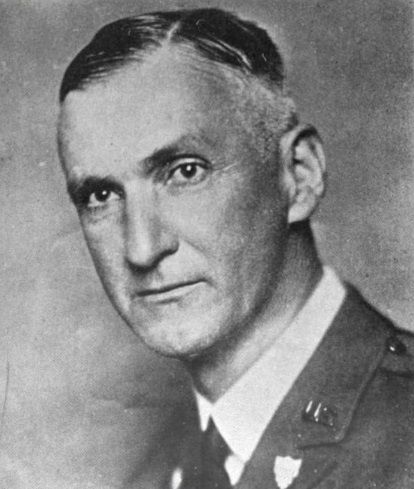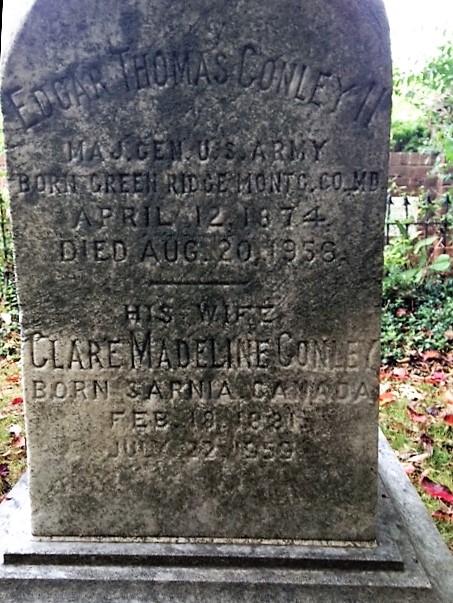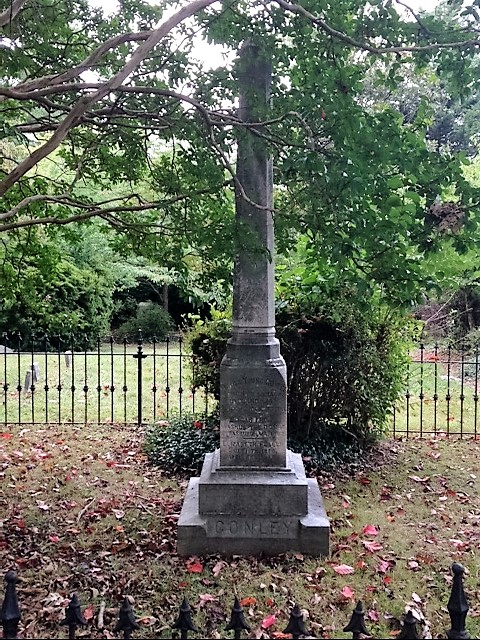- Charles William Conley [1838-1927]
- Martha Ellen (Larrick) Conley [1840-1917]
Married Clare Madeline (Geary) Conley on 7 December 1904 in Niagra, Lincoln, Ontaria, Canada.
Commander of Cadets and Professor of Military Science at the Maryland Agricultural College (University of Maryland)
Tribute from West Point
The beloved Sheriff Conley, President of the Class of 1897, died at his home 20 August 1956.
He was born on his father’s farm, Green Ridge, Fairland, Md., 12 April 1874, the son of Charles and Martha Larrick Conley.
After graduating from Episcopal High School, in Alexandria, VA., he attended Lehigh University for a semester and then entered Braden’s preparatory school in Highland Falls.
On 15 June 1893, he became a plebe and was assigned to D Company, in which he remained during his cadet career. It was as a member of D Company that he was given the nickname by which he was known throughout the Army. Although there are at least two versions of how the name was acquired, apparently the most authentic is that quoted by his classmate Ashburn in the book commemorating the 25th anniversary of the graduation of the Class. According to this account a fight between Alstaetter and Billy Kerns resulted in a trial by a jury of their peers, “men of wise heads and mature judgment from D Company”; the story is continued in Sheriffs own words:
“It fell to my lot to fulfill the duties of sheriff for that momentous trial-such duties including the producing of the bodies of the accused before that august (and self-appointed) tribunal and preventing violence from enraged and excited fellow runts of C Company, whose ravings and threats were of grave concern to those men of D Company by whose hands the cause of justice was to be upheld.
“The Saturday night arrived; the place was Cadet Room, 9th Division, 4th Floor, right-hand commissary. Bodies of the accused were properly produced, accompanied by a runtish rabble following at a respectable distance. The trial was held. Prominent BS—ers from A Company were given ample opportunity to display their oratorical wares in behalf of the accused. The dignified counsel for the state from D Company stated the case in these few words: ‘The accused are guilty’. The order was perfect. The accused were properly and completely tried, condemned, and sentenced, and the court adjourned sine die. Upon me, in consideration of the magnificent performance of those duties as the highest police officer of that honorable court, and as remuneration for the suit of cadet gray which the performance of those duties left in shreds, I was thereafter honored with the title of Sheriff.”
He was a yearling corporal, a 2d Class sergeant and a cadet lieutenant. He was a substitute football player his last two years at the Academy and was on the class tug-of-war team. He toasted the class at the furlough banquet in New York, and toasted the Corps at New Year’s, 1897. He was Class Editor for the Howitzer.
At the first class meeting in 1894, Sheriff was elected Class President. He continued as President until his death. At the 60th reunion of the class, at West Point, in June 1957, the eleven members present at the class dinner unanimously voted not to elect a new President because “nobody can replace Sheriff Conley” After graduation, he was assigned to Company D, 15th Infantry, Fort Bayard, New Mexico Territory. The next May, he joined Company G, 21st Infantry, and went with the company to Cuba a short time later. It was on 1 July 1898, that he was cited for gallantry in action at Santiago and was awarded the Silver Star.
As an officer in Company B of the 21st, he went to the Philippines, where he participated in campaigns around Manila and from San Pedro to Los Penas, Zapoto River, Bacoor, and San Mateo River. On 21 September 1899, the Adjutant General of the 1st Division sent the following message to Colonel Kline:
“Division Commander comments on Lieutenant Conley’s reconnaissance. It was a pretty piece of work. Lieutenant Conley showed courage and judgment.”
The late Major General William S. McNair, Class of ’90, used to tell with obvious pleasure how the smoke of burning villages enabled him to follow the progress of the relief column which Lieutenant Conley was leading to McNair's encircled forces.
After various peacetime assignments in the 21st Infantry, he was transferred to Company K, 8th Infantry, at Fort Niagara. It was here that he met and then married Clare Geary of Toronto. In 1953, the late Master Sergeant E. E. (Pop) Swartwood, the famous chief of the barracks policemen in the '20’s and ’30s, told Sheriff for the first time how, as a sergeant in Company K nearly 50 years before, he had bought a new blue uniform to wear to the Captain’s wedding, which the entire company attended.
After routine peacetime assignments in the United States and again in the Philippines, Sheriff became PMS&T at the University of Maryland. The affection and respect with which he was regarded by his Maryland cadets was exemplified one year by a class dedicating its 25th Reunion book to him.
In August 1917, he was ordered to The Adjutant General’s Office in Washington, as a Lieutenant Colonel, National Army. In 1918, he arrived in France, where he was assigned to the Office of the Provost Marshal General, American Expeditionary Forces, and placed in charge of all German prisoners of war. It was the carrying out of this responsibility that resulted in his receiving the following letter of commendation from American Expeditionary Forces Provost Marshal General.
Following his return to the United States, he transferred as a Colonel, Regular Army, to The Adjutant General’s Department in May 1922.
Upon the death of his father, in 1927, Sheriff inherited the farm on which he was born, and moved to it to live while on duty in Washington, then Baltimore, and then again in Washington. Devoted to his land, he delighted in spending every Wednesday and Saturday half-holiday and every leave on the innumerable tasks of the farmer. On Sundays, the farm was a gathering place of the Conleys’ old friends, including the many members of the Class living in Washington.
He was made Assistant The Adjutant General, 1 June 1933, and was appointed The Adjutant General, 1 November 1935. General Malin Craig, who was at the time Chief of Staff, let it be known that Sheriff’s promotion to Major General and designation as The Adjutant General only 32 months prior to his mandatory retirement for age were in recognition of distinctively outstanding ability, and that no more appointments as chiefs of branches or services would be made of officers with less than four years of active duty remaining.
Retirement for Sheriff Conley was not a matter of great readjustment to an entirely new way of life. To him, retirement meant that, instead of half-holidays and leaves, he could spend all of his time working on the farm to which he was so greatly attached. As a farmer, he won the same eminent success that he had won as a soldier. He kept abreast of the latest developments at the Maryland Experimental Agriculture Station near his home and was quick to adopt those appropriate to the products of his farm, with result that both his livestock and his grain were not only better than the average throughout that rich agricultural area but were several times judged to be the best in the area.
Further, retirement gave him the opportunity to give more of his time, effort and money to the Episcopal chapel a short distance from the farm. It was at this chapel, in the cemetery of which his grandparents, his mother, father and sister are buried, and at whose altar his daughter was married and his grandchildren were christened, that Sheriff most clearly demonstrated his deeply religious convictions. And in this chapel the funeral services were held and in this cemetery he was buried.
He is survived by his widow; two sons, Brigadier General Edgar T. Conley, Jr., and Reginald G. Conley; his daughter, Mrs. Thomas M. Watlington; six grandchildren and four great-grandchildren.
Obituary
Washington Post - August 21, 1956
On Monday, August 20, 1956, at his home "Green Ridge", on the Columbia Pike near Fairland, Md., Maj. Gen. Edgar T. Conley, USA, (ret.), beloved husband of Clare M. Conley and father of Brig. Gen. Edgar T. Conley, Jr., Mrs. Thomas M. Watlington, and Reginald G. Conley.
Maj. Gen. Conley rests at his late home. Service on Wednesday, August 22, at 3 p.m. at St. Mark's Episcopal Church, Fairland, Md. Interment Church Cemetery.
- Charles William Conley [1838-1927]
- Martha Ellen (Larrick) Conley [1840-1917]
Married Clare Madeline (Geary) Conley on 7 December 1904 in Niagra, Lincoln, Ontaria, Canada.
Commander of Cadets and Professor of Military Science at the Maryland Agricultural College (University of Maryland)
Tribute from West Point
The beloved Sheriff Conley, President of the Class of 1897, died at his home 20 August 1956.
He was born on his father’s farm, Green Ridge, Fairland, Md., 12 April 1874, the son of Charles and Martha Larrick Conley.
After graduating from Episcopal High School, in Alexandria, VA., he attended Lehigh University for a semester and then entered Braden’s preparatory school in Highland Falls.
On 15 June 1893, he became a plebe and was assigned to D Company, in which he remained during his cadet career. It was as a member of D Company that he was given the nickname by which he was known throughout the Army. Although there are at least two versions of how the name was acquired, apparently the most authentic is that quoted by his classmate Ashburn in the book commemorating the 25th anniversary of the graduation of the Class. According to this account a fight between Alstaetter and Billy Kerns resulted in a trial by a jury of their peers, “men of wise heads and mature judgment from D Company”; the story is continued in Sheriffs own words:
“It fell to my lot to fulfill the duties of sheriff for that momentous trial-such duties including the producing of the bodies of the accused before that august (and self-appointed) tribunal and preventing violence from enraged and excited fellow runts of C Company, whose ravings and threats were of grave concern to those men of D Company by whose hands the cause of justice was to be upheld.
“The Saturday night arrived; the place was Cadet Room, 9th Division, 4th Floor, right-hand commissary. Bodies of the accused were properly produced, accompanied by a runtish rabble following at a respectable distance. The trial was held. Prominent BS—ers from A Company were given ample opportunity to display their oratorical wares in behalf of the accused. The dignified counsel for the state from D Company stated the case in these few words: ‘The accused are guilty’. The order was perfect. The accused were properly and completely tried, condemned, and sentenced, and the court adjourned sine die. Upon me, in consideration of the magnificent performance of those duties as the highest police officer of that honorable court, and as remuneration for the suit of cadet gray which the performance of those duties left in shreds, I was thereafter honored with the title of Sheriff.”
He was a yearling corporal, a 2d Class sergeant and a cadet lieutenant. He was a substitute football player his last two years at the Academy and was on the class tug-of-war team. He toasted the class at the furlough banquet in New York, and toasted the Corps at New Year’s, 1897. He was Class Editor for the Howitzer.
At the first class meeting in 1894, Sheriff was elected Class President. He continued as President until his death. At the 60th reunion of the class, at West Point, in June 1957, the eleven members present at the class dinner unanimously voted not to elect a new President because “nobody can replace Sheriff Conley” After graduation, he was assigned to Company D, 15th Infantry, Fort Bayard, New Mexico Territory. The next May, he joined Company G, 21st Infantry, and went with the company to Cuba a short time later. It was on 1 July 1898, that he was cited for gallantry in action at Santiago and was awarded the Silver Star.
As an officer in Company B of the 21st, he went to the Philippines, where he participated in campaigns around Manila and from San Pedro to Los Penas, Zapoto River, Bacoor, and San Mateo River. On 21 September 1899, the Adjutant General of the 1st Division sent the following message to Colonel Kline:
“Division Commander comments on Lieutenant Conley’s reconnaissance. It was a pretty piece of work. Lieutenant Conley showed courage and judgment.”
The late Major General William S. McNair, Class of ’90, used to tell with obvious pleasure how the smoke of burning villages enabled him to follow the progress of the relief column which Lieutenant Conley was leading to McNair's encircled forces.
After various peacetime assignments in the 21st Infantry, he was transferred to Company K, 8th Infantry, at Fort Niagara. It was here that he met and then married Clare Geary of Toronto. In 1953, the late Master Sergeant E. E. (Pop) Swartwood, the famous chief of the barracks policemen in the '20’s and ’30s, told Sheriff for the first time how, as a sergeant in Company K nearly 50 years before, he had bought a new blue uniform to wear to the Captain’s wedding, which the entire company attended.
After routine peacetime assignments in the United States and again in the Philippines, Sheriff became PMS&T at the University of Maryland. The affection and respect with which he was regarded by his Maryland cadets was exemplified one year by a class dedicating its 25th Reunion book to him.
In August 1917, he was ordered to The Adjutant General’s Office in Washington, as a Lieutenant Colonel, National Army. In 1918, he arrived in France, where he was assigned to the Office of the Provost Marshal General, American Expeditionary Forces, and placed in charge of all German prisoners of war. It was the carrying out of this responsibility that resulted in his receiving the following letter of commendation from American Expeditionary Forces Provost Marshal General.
Following his return to the United States, he transferred as a Colonel, Regular Army, to The Adjutant General’s Department in May 1922.
Upon the death of his father, in 1927, Sheriff inherited the farm on which he was born, and moved to it to live while on duty in Washington, then Baltimore, and then again in Washington. Devoted to his land, he delighted in spending every Wednesday and Saturday half-holiday and every leave on the innumerable tasks of the farmer. On Sundays, the farm was a gathering place of the Conleys’ old friends, including the many members of the Class living in Washington.
He was made Assistant The Adjutant General, 1 June 1933, and was appointed The Adjutant General, 1 November 1935. General Malin Craig, who was at the time Chief of Staff, let it be known that Sheriff’s promotion to Major General and designation as The Adjutant General only 32 months prior to his mandatory retirement for age were in recognition of distinctively outstanding ability, and that no more appointments as chiefs of branches or services would be made of officers with less than four years of active duty remaining.
Retirement for Sheriff Conley was not a matter of great readjustment to an entirely new way of life. To him, retirement meant that, instead of half-holidays and leaves, he could spend all of his time working on the farm to which he was so greatly attached. As a farmer, he won the same eminent success that he had won as a soldier. He kept abreast of the latest developments at the Maryland Experimental Agriculture Station near his home and was quick to adopt those appropriate to the products of his farm, with result that both his livestock and his grain were not only better than the average throughout that rich agricultural area but were several times judged to be the best in the area.
Further, retirement gave him the opportunity to give more of his time, effort and money to the Episcopal chapel a short distance from the farm. It was at this chapel, in the cemetery of which his grandparents, his mother, father and sister are buried, and at whose altar his daughter was married and his grandchildren were christened, that Sheriff most clearly demonstrated his deeply religious convictions. And in this chapel the funeral services were held and in this cemetery he was buried.
He is survived by his widow; two sons, Brigadier General Edgar T. Conley, Jr., and Reginald G. Conley; his daughter, Mrs. Thomas M. Watlington; six grandchildren and four great-grandchildren.
Obituary
Washington Post - August 21, 1956
On Monday, August 20, 1956, at his home "Green Ridge", on the Columbia Pike near Fairland, Md., Maj. Gen. Edgar T. Conley, USA, (ret.), beloved husband of Clare M. Conley and father of Brig. Gen. Edgar T. Conley, Jr., Mrs. Thomas M. Watlington, and Reginald G. Conley.
Maj. Gen. Conley rests at his late home. Service on Wednesday, August 22, at 3 p.m. at St. Mark's Episcopal Church, Fairland, Md. Interment Church Cemetery.
Family Members
Sponsored by Ancestry
Advertisement
Explore more
Sponsored by Ancestry
Advertisement














